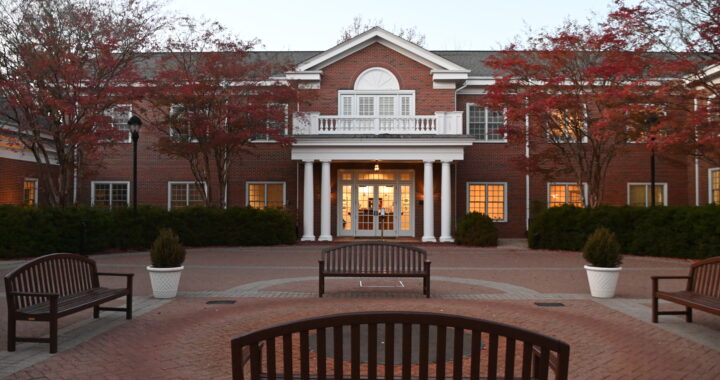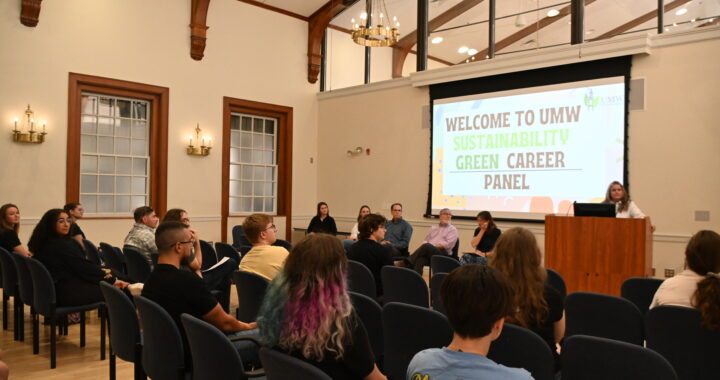The Bullet Through Time
6 min readBy ERIC STEIGLEDER
In this week of centennial celebration, the importance of reflection comes to the fore. And what better way is there to remember the history of our school than by seeing it through the eyes of the campus’ student paper?
From its first incarnation in 1922 as a monthly, four-page news magazine to the current paper picked up (and occasionally read) every Thursday, the Bullet has been an integral part of the Mary Washington community.
The school’s paper has been a constant ledger for campus history, culture and oddities.
It was interrupted only rarely by irregularities like the 1942 “Emergency Issue” that reported about a flood that had left all of Fredericksburg in a complete state of disarray, leaving the printers in Richmond unable deliver the Bullet.
The staff at the time decided to publish the paper on mimeographed pages, complete with little drawings at the corners.
Perhaps the strangest issue included a “Special April Fool’s Insert” from 1980, in which a mock Bullet bore the name “The Bullshit – George Washington’s Mother’s College.”
In it, an article claimed that Mary Washington was planning on changing its name to “United Negro College,” stating that the name-change was in needed in order to “receive money from the United Negro College Fund.”
Whatever quirks and crises have gone into shaping what is now our University of Mary Washington, the Bullet was there to give
While the Bullet has changed over the years, it’s has held firm as Mary Washington’s school newspaper; capturing the best and worst of what went into making this school what it is.
In the words of an unnamed writer from a 1952 issue of the Bullet, “You are the people of Mary Washington; Mary Washington is your school; The Bullet is your paper; use it as you need.”
EARLY YEARS
The first issue of the Bullet on record is the third published. At that time, Mary Washington was known as “The State Normal School,” a fact that is good to know at the outset, given that each article references “The Normal” as shorthand for the college.
This early era focused on complete coverage of all things “Normal.” Often unnamed writers reference people by their first names only, teachers by their pet names and various incidents on campus with little or no context.
The first few issues of the Bullet seem to be a cavalcade of inside jokes written by the staff for their friends.
After a March 10, 1922 article reported that the new title of “Liberal Arts College” might be bestowed upon a Virginia school; many students offered their opinions on the coming change.
One student stated, “No definite effort has been made to select a name for the new college, but it has been…suggested that ‘Mary Washington College for Women’ be chosen.”
However, it wasn’t until 1944 that the Bullet featured “The Mary Washington College of the University of Virginia” under its letterhead; finally establishing the school as both a liberal arts institution and (for a time) the sister school to U.Va.
A WOMEN’S COLLEGE
The role of women in the school and in larger society has been an interesting facet of Bullet reporting.
A Feb. 26, 1932 article suggested that young women of the college should view the ongoing Great Depression as “your best friend,” explaining the idea that the “good looking gentlemen in the bread line” will come running to you once you “offer him a home and three meals a day.
In a 1935 article, reporters asked Mildred Ware why she chose Home Economics as her major. She answered that “her family…thought it appropriate training for married life!”
Another issue from 1932 offered the advice that, in order to be cute, one must “diet, be indifferent, bluff and gossip.”
Just one year later, an article asserted that, “Now that a woman’s place in the business world goes practically undisputed…can women get anywhere in politics?”
Later, into the 70s, the front page is awash with news about desired changes in abortion laws, the introduction of a course on feminine psychology, and quotes from numerous girls, one of which bluntly states, “Suburbia is a female ghetto.”
POLITICS ON PAPER
In the late 1940s, small bits of racial awareness began to seep into the Bullet, culminating in the Feb. 10, 1948 issue.
In an article entitled “Our World”, an unnamed writer says, “Shall it continue that the so called citadel of democracy give its civil rights to a select number?…we ought to fulfill out duties as a democracy or stop calling ourselves a democratic nation.”
As time progressed, racial tensions became a fixture for the paper.
A race relations committee formed in 1963 with the expressed the intent to “integrate Mary Washington College.”
Chancellor Simpson, the equivalent to president at the time, approved of the committee, but urged caution “since we are in an area of racial tension.”
The Bullet in the1960s and 70s bears witness to the political awareness and activism that dominated the time.
March of 1965 witnessed the first recorded on-campus protest. The protesters were responding to racial tensions brought about by Martin Luther King Jr.’s march on Selma.
Entitled “Mary Washington Picketing Protests Selma,” the article reports that 26 students and two faculty members joined fifty townspeople in picketing the Federal Circuit Court Building “in protest against police brutality exercised against those in Alabama.”
When the political awareness of Mary Washington students was brought into question in 1960, in an editorial entitled “The Ivory Tower” defended the activism of the women of the college.
“MWC students have been accused of ignoring national and international topics,” states the writer, yet she sees “the number of newspapers delivered daily to each dorm…the number of girls crammed around TV sets to see the Kennedy/Nixon debate.”
The wave of politics injected into the Bullet was brought to the forefront after the 1963 assassination of President Kennedy. After, the paper went unpublished from Nov.16 to Dec. 14. It returned to print with a tribute to John F. Kennedy written by Chancellor Simpson.
Discussion of the proposed Equal Rights Amendment later dominated a number of articles in 1974, with the telling statement “Why is there so little support for the Equal Rights Amendment on a predominately female campus?”
Amnesty for draft dodgers appeared as a hot topic in a 1976 issue in which the author of “Amnesty: Bring the Boys Home” opposed the opinion that people avoiding the draft into the Vietnam war are cowards. She instead asserted, “The real cowards were those involved in atrocities.”
WAR IN WORDS
Another “Bullet Special Edition” was created 1970 using mimeographed pages. This time it was to more effectively organize a mass demonstration protesting the extension of the Vietnam War into Cambodia.
According to the front page, the students had already “produced a strike committee and a tentative schedule of events,” complete with a “refusal to patronize Fredericksburg merchants who do not display openly some form of support for the strike cause.”
This movement eventually culminated in a march on the Pentagon.
The atmosphere of Nixon-hatred was enough, according to the Bullet, that Mrs. Nixon canceled her trip to personally visit Mary Washington.
Reporting of wartime events was also common in the 40s during the United States’ involvement in World War II.
During this era at the college, patriotism was at a fever pitch, with numerous articles offering tips such as, “Trust those in authority. They are the only ones in a position to know the facts.”
A wartime curriculum included courses in Russian history, mathematics, science, and democratic theory.
In 1942, the college received the task of “taking over the plane spotting station,” where junior and senior students would keep watch for a possible bombing attack on the home front.
That same year, a strange piece entitled “College Girl…1952,” appeared. The article predicted the look and feel of the “war time college girl…one who bears a definite responsibility…a world of…blood, thunder, sweat, tears, death and destruction.”


